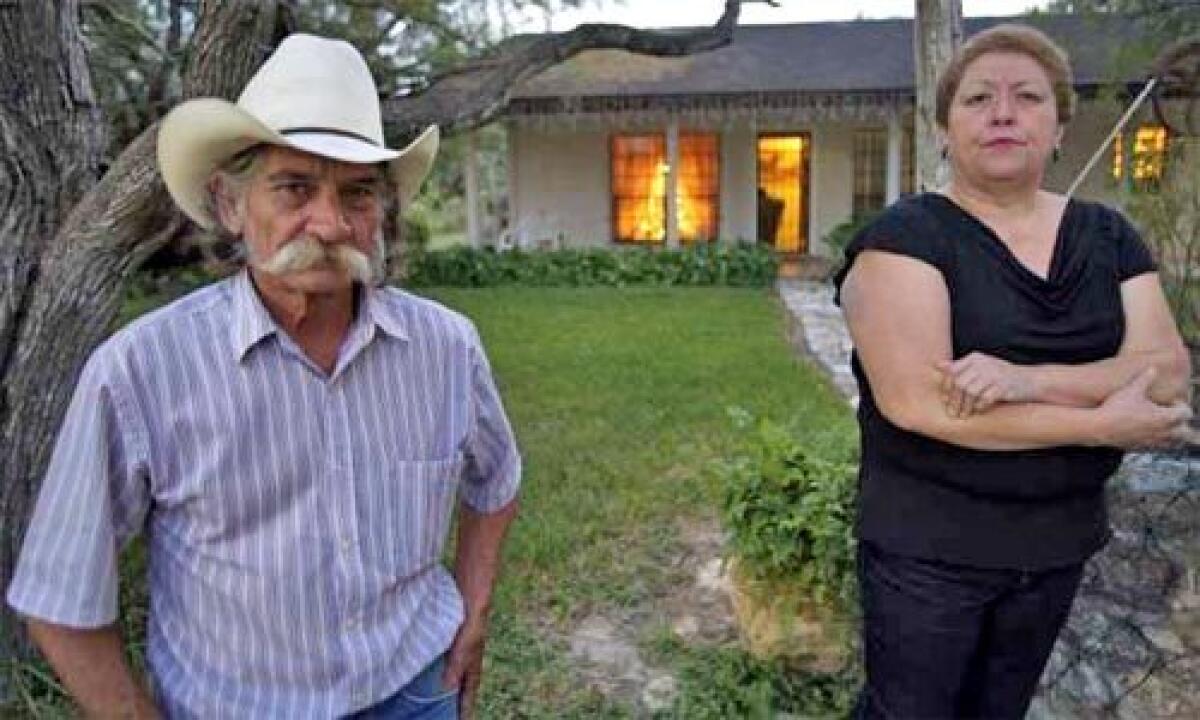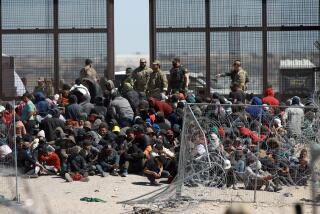A town against the wall

Gloria Garza doesn’t have a whole lot. But what she has, she clings to with pride.
She lives in a simple stucco house with a rustic wooden veranda and a well fashioned from odd stones her husband found around the state. Kittens stretch lazily in the sun beside her porch. Armadillos dart across her backyard.
Her two-acre lot is her heirloom, her link to a legacy that dates to 1767, when Spain’s King Carlos III gave her pioneer ancestors a porcion of property that started at the Rio Grande and stretched inland for miles.
So she is not going to be quiet while some bureaucrat in Washington tries to take it -- to build a border fence. She doesn’t want to become an unintended victim in a war against illegal immigration that she sees as misguided and wrong.
“It would be heartbreaking,” said Garza, 51, who teaches tots in a Head Start program. “For us, this place has a sentimental value that is worth more than any amount of money.”
Granjeno is a frontier town of about 400 people, where everyone seemingly lives a door down from their uncle and descends from the same rancheros. It outlasted the rule of Spain, Mexico and the independent Republic of Texas. But it might not survive the U.S. government’s plan to build 370 miles of steel fencing along the border with Mexico.
Blueprints show that about a third of Granjeno’s house lots lie in the fence’s path, even though the town sits more than a mile from the Rio Grande, the dividing line between the U.S. and Mexico. The fence would run alongside an earthen levee that passes just south of Granjeno, because federal officials fear that if it were built by the river it would be worn away by flooding.
“I always thought, I’ll serve my country, they’ll pay me a little money and I’d build my house here and retire,” said Mayor Alberto Magallan, 73, a 20-year Air Force veteran. “Now, a government man comes and tells me he’s going to take my land? It’s not right.”
Granjeno weathered the racially charged land fights that shook the Rio Grande Valley after the Civil War, when Anglo newcomers acquired property through schemes that included using the Texas Rangers to intimidate the Tejanos, earlier Texans of Mexican or Spanish descent.
Granjeno persevered again a decade ago, when it fought off Hidalgo County power brokers who decided that the path to prosperity after the North American Free Trade Agreement was a big bridge to Mexico that would run right over the town and consume much of it.
But this fight may be the last for Granjeno, which is named for a thorny shrub with bright orange berries that is said to bloom more beautifully here than anywhere else.
Federal officials stress that the fence’s location in Granjeno, just like the rest of the 70 miles of border walls being planned for the lower Rio Grande Valley, is subject to change.
“No final decisions have been made in the construction of fencing in that area,” said Michael Friel, a spokesman for U.S. Customs and Border Protection in Washington. “The input from the community will be a vital part of the process.”
Yet Border Patrol leaders have made it clear that they believe places like Granjeno -- where drug smugglers and illegal immigrants can cross the river and slip into someone’s house within minutes -- are where physical barriers are needed most.
Wary locals note that government officials have already been knocking on doors, asking residents to sign release forms granting access to their properties so that surveyors can begin plotting where the fence will go. Many old-timers refused to sign, worried that if the properties are condemned, Granjeno will be too small to carry on.
In response to similar resistance all along the border in Texas, Homeland Security Secretary Michael Chertoff said this month that he would take landowners to court to seize property if needed, and also pledged that he would not pay more than market price for land.
Some in Granjeno argue that as descendants of the Spanish land grant families, they have property rights that the federal government cannot take away. A few attorneys think they may be right and recently offered to represent Granjeno’s citizens pro bono. But in a post-Sept. 11 environment, legal experts said, there’s virtually no chance of stopping a fence that’s touted as a way to make the nation safer.
“The way things look, nothing is going to be left,” said Garza’s uncle, Daniel Garza, 73. “Then two miles west, the fence is going to stop. Do they really think people won’t go around?”
Similar complaints are heard from El Paso to Brownsville, in river towns only a football field away from sister cities in Mexico, where the prevailing culture has long been bilingual and binational, and where everyone knows someone on the other side.
Many border residents still can’t believe that a fence they ridiculed as a politician’s pipe dream is about to become reality. They’re stunned that the wild river that served as the playground of their youth will soon look like a military zone.
But in Granjeno, the mood is especially melancholy. People feel like they are being fenced off from their heritage.
Granjeno was once a rambling expanse of small ranchos that spanned thousands of acres of brushy country.
The homesteads were owned by descendants of the land-grant families, the Munguias and the Bocanegras, and Tejano families such as the Garzas and Anzalduas that got parcels through business deals and marriages. Most existed well before the Treaty of Guadalupe Hidalgo, which recognized the Rio Grande as the border between Texas and Mexico in 1848.
“We didn’t come to the United States,” said Rey Anzaldua, 62. “The United States came to us.”
Citrus farms, housing developments and flood-control projects chipped away at Granjeno over the last century, leaving little but some working-class families with historic last names. Now the town is just a city hall, a church, a cluster of small houses and one business -- a bar with cinder-block walls named Cabrera’s Place -- all crammed into a third of a square mile. Crumbling plaster-coated buildings teeter next to sturdy brick homes. Ponies wander in fenced yards beside broken-down trucks.
Granjeno is so poor that until it recently installed solar-powered lamps, its streets went dark at night. The per-capita income is $9,022. Half of the population lives below the poverty line. It only got around to incorporating as a city in the last decade, when the border bridge threatened its existence. The town has little political clout in today’s lower Rio Grande Valley, one of the nation’s fastest-growing regions.
“We have no voice in government,” said Granjeno’s unofficial historian, Yolanda Martinez, 61, who is Rey Anzaldua’s sister. “Money talks, and we have none.”
Though Granjeno is short on wealth, it is rich in tradition. Families that left years ago dutifully return to bury their dead in pastoral El Granjeno Cemetery. It was founded in 1872 by the heir to a sheep ranch named Don Juan Garza to inter his brother Antonio, who was killed in a gunfight across the river in Reynosa.
Fresh flowers adorn family plots memorializing men who served in the Civil War, World War II and Vietnam. Among the marble and brick gravestones is a marker for Sgt. Luis Ramirez, who reportedly meant to sign up for the Confederacy like most Texans but mistakenly enlisted with the Union side instead.
Sotero Anzaldua, 39, who trims the trees and keeps the gravestones clean, thinks a border fence may do some good.
“The government has a right to do what it wants,” he said in Spanish. He blamed river-crossers for a burglary at his brother’s house.
But most here don’t believe illegal immigration is becoming worse, or was ever bad. Gloria Garza fondly recalled that her mother used to leave aromatic plates of tacos on her porch at night -- a token of Tejano hospitality for the migrants trudging north.
If anything, the clannish Granjeno folk -- who shift easily between Spanish and English, often midsentence -- seem more leery of newcomers such as the Border Patrol and the Minutemen than they are of illegal immigrants and drug-runners.
Anyone not native to Granjeno is always going to be viewed with suspicion by some, no matter how long they’ve been around.
“He’s still on probation!” joked former Mayor Vicente Garza, 55, pointing to his 79-year-old neighbor.
Felix de la Cruz, who fell in love with a Granjeno girl when Harry Truman was president, has lived in town since 1951.
Napoleon Garza wanted to show off a side of old Granjeno that was fast fading into memory. So the 31-year-old son of Vicente Garza, and nephew of Gloria Garza, hopped into his dilapidated car and headed beyond the earthen levee toward the Rio Grande.
The government had condemned many acres in Granjeno to build the levee during the 1970s. But there were still a few isolated homesteads to the south, including one with a perimeter of cactuses serving as a crude fence, and another that was inhabited by a man of scant words whom locals called “The Mexican Redneck.”
The redneck wasn’t home, so Garza drove over a dead cottonmouth snake and kept going until he reached a resaca, or abandoned riverbed, where the Rio Grande ran decades ago before shifting course. Then he headed for the river.
“This is what I’m going to miss,” he said as he stood by the banks, staring at the slowly moving water. For all his life he has hunted javelinas, pig-like critters, at this spot, he explained.
Next he drove a few minutes west to the site of another massive public works project that was taking shape. Construction crews were lining up orderly rows of monolithic concrete pillars -- the foundation for the international bridge Granjeno had successfully fought against a decade ago. It was being built just outside the town.
Called the Anzalduas Bridge, it’s expected to ease long wait times at the border when it opens in 2009. With the bridge and the border fence, Granjeno would be walled off by manufactured structures on two sides.
Garza walked down to the slope where the 10-foot-tall Carrizo cane weeds had been cleared in preparation for the final pillars, and began chatting up a Mexican man who sat minding a fishing pole on the opposite bank, which was less than 50 yards away.
“He’s a lookout,” Garza concluded, and drove back to town.
Minutes earlier, Garza had pointed out that he was running over one of the electronic sensors the Border Patrol plants in the ground to detect movements. Soon, he predicted, he’d have company.
As he pulled into Granjeno, a white Border Patrol truck raced up.
The agent quickly realized he was dealing with locals, not drug-runners, and sped away. But that did not stop a car full of neighborhood kids from pulling beside Garza and shouting “Dame la maleta!” (“Give me the suitcase!”) to make fun of the border cop who mistook Garza for a smuggler.
Garza ignored them.
“Pretty soon, it will all be behind the wall,” he said sadly. “I won’t even be able to pick blackberries down there no more.”
More to Read
Start your day right
Sign up for Essential California for news, features and recommendations from the L.A. Times and beyond in your inbox six days a week.
You may occasionally receive promotional content from the Los Angeles Times.






